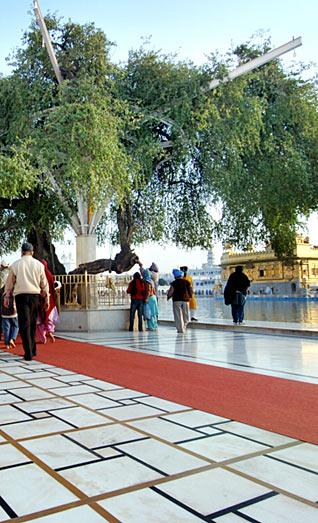
Celestial Glory : The Kalp Vriksh - Gurudwara Kalp Vriksh Sahib at Attari, Ropar
|
The uniqueness of identifying Gurdwaras with common Punjabi trees is unprecedented. Even the Gurbani refers to various species of trees, which are useful to mankind. "Sikhism is not only one of the most modern and scientific religions but is also environment friendly," says Mr Damanbir Singh Jaspal, an IAS officer of the 1976 batch, who has just completed his research, documenting 48 historic Sikh shrines that are commemorated by the names of 17 native species of trees. This uniqueness of identifying its most sacred places of worship with common trees is unprecedented. Perhaps no other religion has given importance to vegetation the way Sikhism has. If trees and forests were the centre for meditation and communion with the Creator for the first five Sikh Gurus, they provided security, shelter and sustenance for the last five Gurus who spent most of their time in the jungles, fighting the Muslims. Says Mr Jaspal: "The profusion of allusions and references to trees, nature and environment in Guru Granth Sahib and the commemoration of scared shrines by popular species of trees can be explained by the vigorous outdoor life and travels of the Sikh Gurus, who were probably the most mobile among all religious preachers of the world." Even the Gurbani refers to various species of trees, eulogising species, which are useful to mankind. The Gurus inferred that it is not the girth, size, or beautiful flowers that determine the significance of a tree but it is its usefulness that makes it important for mankind. That may perhaps be the reason that "Simbal", a huge tree with big attractive colourful flowers, did not find favour with them. "Simbal rukh saraira, This sloka from the Gurbani says that though the tree of Simbal is a huge tree and has big colourful flowers that attract birds, they go back disappointed as the flowers lack nectar. Even the leaves of the tree are of no use. It is not the huge size but humbleness that marks usefulness. Of the 17 species of trees researched by Mr Jaspal during his six-month long project, he found that since zizyphus jube has sweet fruit; Jand (prospis spicigera) has leaves that are used for feeding horses; Neem (margassa) has medicinal value; Tahli (shisham, state tree of Punjab) has wood; Imli (tamarind) has both food and medicinal value; they found favour with the Sikh Gurus. The trees that have sanctity in Sikhism include Bohr (Ficus bengalensis), Pipli (Ficus religiosa), Jand (Prosopis spicigera), Garna (Capparis horrida), Karir (Capparis aaphylla), Phalahi (Acacia modeta), Reru (Mimasa leucophloea), Luhura (Cordia latifolia), Tahli (Shisham), Imli (Tamarind), Amb (Mangifera indica), Harian velan, Neem (margassa), Ritha (Sapindus mukorosa), Kalp (Mitragina parvifolia) and Ber (Zizyphus jujube), says Mr Jaspal. Clusters of such useful trees were invariably the sites selected by the travelling Gurus as the halting places for shade as well as shelter. Besides these trees were also sources of nourishment for the Guru’s entourage. After the departure of the Guru from the site, the trees were remembered for their association with the Guru and were later commemorated by building shrines around them. It is one reason why, he says, some of the trees preserved in historic shrines were older than 400 years. One such example is Gurdwara Tahli Sahib in Garhshankar in Nawanshahr. Dr Jaspal’s research took him to Leh where Guru Nanak had gone during his second of the four Udasis. The local legend in Leh has it that Datun (Margossa) sprouted from a datunplanted by Guru Nanak. The tree is greatly revered by Muslims and Buddhists alike for its sanctity, adds Mr Jaspal. Though Mr Jaspal plans to write a book soon, he has decided to hold exhibitions of the photographs of these 48 historic shrines featuring the 17 species of trees. The entire project has been sponsored by the WWF. Says he: "It was interesting as it not only took me to all historic Sikh shrines but provided me with an insight into how scientific Sikh Gurus were. The world started talking about environment and ecological balance only during the past three to four decades while the Gurus realised their significance more than 500 years ago. In the same manner, the world has realised how dangerous smoking is for human beings. And the Gurus had prohibited their disciples from smoking." Mr Jaspal has now decided to pursue his interest further through his Chandigarh Nature and Health Society, an NGO which has obtained stems of four of the most sacred trees associated with the Sikh shrines, namely beri of Dukh Bhanjani Beri of Sri Harmandir Sahib, Beri of Baba Budha (also of Sri Harmandir Sahib), Beri of Gurdwara Ber Sahib of Sultanpur Lodhi and Beri of Lachi Ber of Sri Harmandir Sahib. Inducement of rooting in these stems is now being attempted in simulated environment through a mist chamber, shade house, growth hormones to promote rooting, adds Mr Jaspal, hoping that "propagation of these historic trees will generate awareness and respect for nature in general and environment in particular. Photos by Damanbir Singh Jaspal - Top of this Page: Ber Baba Buddha ji, Durbar Sahib, Amritsar. Bottom photo: Gurdwara Luhura Sahib, Lahore, Pakistan. Second from bottom: Gurdwara Kalp Vriksh, Ropar. Third from bottom: Gurdwara Tahli Sahib, Hoshiarpur. "Tryst with Trees: Punjab's Sacred Heritage" |
    |
Related articles:
Historic Gurdwaras and trees pay the price for modernization
